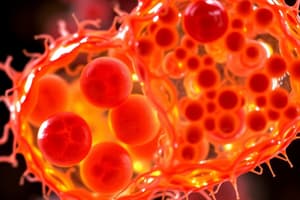Podcast
Questions and Answers
What are Koch's postulates designed to establish?
What are Koch's postulates designed to establish?
- A relationship between a microbe and a disease (correct)
- A relationship between nutrition and health
- A relationship between environmental factors and disease
- A relationship between pathogens and antibiotics
How many criteria are included in Koch's postulates?
How many criteria are included in Koch's postulates?
- Four (correct)
- Five
- Two
- Three
In which year were Koch's postulates formulated?
In which year were Koch's postulates formulated?
- 1981
- 1884 (correct)
- 1875
- 1918
Who discovered the parasite infecting the silk worm?
Who discovered the parasite infecting the silk worm?
What term describes the ability of an organism to establish itself in a new host?
What term describes the ability of an organism to establish itself in a new host?
Which of the following bacteria is responsible for tuberculosis?
Which of the following bacteria is responsible for tuberculosis?
In the context of pathogenic bacteria, where should these bacteria NOT be found?
In the context of pathogenic bacteria, where should these bacteria NOT be found?
According to Koch's postulates, where must a pathogenic microorganism be re-isolated from?
According to Koch's postulates, where must a pathogenic microorganism be re-isolated from?
What is the term for long-term interactions between different biological species?
What is the term for long-term interactions between different biological species?
Which of the following is typically a macromolecular component that interacts with host cell receptors?
Which of the following is typically a macromolecular component that interacts with host cell receptors?
What defines the interaction of bacterial ligands with host cell receptors?
What defines the interaction of bacterial ligands with host cell receptors?
Which of the following is NOT a term used to describe adherence factors in microbiology?
Which of the following is NOT a term used to describe adherence factors in microbiology?
Which factor is crucial for the adherence of bacteria to host cells?
Which factor is crucial for the adherence of bacteria to host cells?
Which type of relationship is described when one organism benefits while the other is harmed?
Which type of relationship is described when one organism benefits while the other is harmed?
When one organism is harmed while another remains unaffected, what is this relationship called?
When one organism is harmed while another remains unaffected, what is this relationship called?
What term refers to the action of an organism that suppresses or interferes with the growth of a pathogen?
What term refers to the action of an organism that suppresses or interferes with the growth of a pathogen?
Which of the following is NOT typically found in tissues of the human body?
Which of the following is NOT typically found in tissues of the human body?
What term is used to refer to the mixture of organisms at any anatomical site?
What term is used to refer to the mixture of organisms at any anatomical site?
What is used to grade an organism's ability to cause disease?
What is used to grade an organism's ability to cause disease?
Which type of flora is regularly found inside the body but usually does not cause disease?
Which type of flora is regularly found inside the body but usually does not cause disease?
What measurement is used to compare virulence between different strains of the same organism?
What measurement is used to compare virulence between different strains of the same organism?
Flashcards are hidden until you start studying
Study Notes
Eukaryotic Cell Interaction
- Requires participation of two factors: a receptor and a ligand.
- Receptors are usually specific carbohydrate or peptide residues on eukaryotic cell surfaces.
- Bacterial ligands, known as adhesins, are typically macromolecules on bacterial cell surfaces that interact with host cell receptors.
Adherence Factors in Microbiology
- Important terms include Adhesin, Receptor, Fimbriae, Biofilm, Capsule.
- These factors describe how bacteria adhere to host cells.
Diseases and Pathogens
- Tuberculosis is caused by Mycobacterium tuberculosis.
- Pathogenic bacteria must be abundant in suffering organisms but absent in healthy ones.
- Koch's postulates require re-isolation of microorganisms from an inoculated diseased host.
Biological Interactions
- Symbiosis is defined as long-term interactions between species, which can be mutualistic, commensal, or parasitic.
- Parasitism involves a relationship where one organism benefits at the expense of another.
- Amensalism occurs when one organism is harmed while another remains unaffected.
Microbiota and Normal Flora
- Microorganisms are typically found in intestinal, skin, and other tissues but not usually in muscle or blood.
- The mixture of organisms at any anatomical site is referred to as Normal flora.
- Resident flora consists of organisms regularly found inside the body or on surfaces, often non-pathogenic but opportunistic.
Virulence and Disease Causation
- Virulence measures an organism's ability to cause disease, often quantified using the LD50.
- Colonization is used to measure virulence between strains of the same organism.
Koch's Postulates
- Koch's postulates consist of four criteria to establish causative relationships between microbes and diseases.
- Formulated by Robert Koch and Friedrich Loeffler in 1884.
- Showed that parasites can infect hosts, as demonstrated in silk worms by Louis Pasteur.
Key Concepts in Microbial Pathogenesis
- Infectivity refers to the capability of an organism to establish itself in a new host.
- Adherence involves mechanisms that allow pathogens to cling to host tissues.
Studying That Suits You
Use AI to generate personalized quizzes and flashcards to suit your learning preferences.




